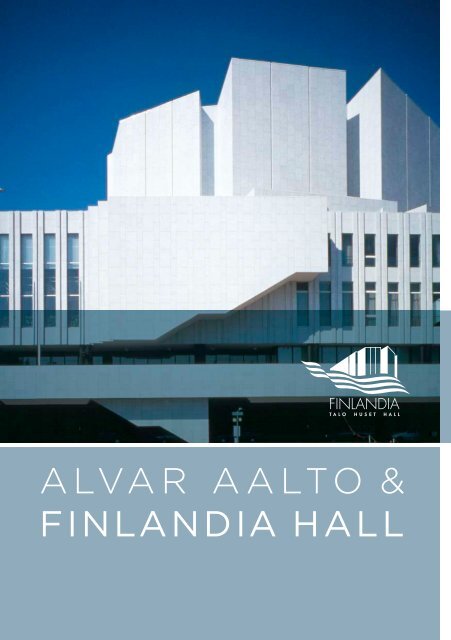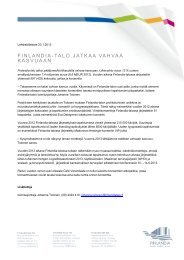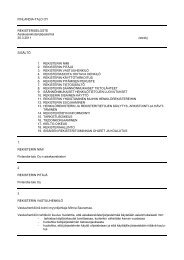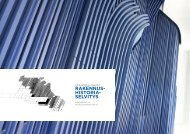ALVAR AALTO & FinLAnDiA HALL - Finlandia-talo
ALVAR AALTO & FinLAnDiA HALL - Finlandia-talo
ALVAR AALTO & FinLAnDiA HALL - Finlandia-talo
Create successful ePaper yourself
Turn your PDF publications into a flip-book with our unique Google optimized e-Paper software.
A LVA R A A LTO &<strong>FinLAnDiA</strong> <strong>HALL</strong>
ALVA R A A LTO &To be able to understand the architecture of <strong>Finlandia</strong> Hall, onemust be familiar with the larger vision of Helsinki of which <strong>Finlandia</strong>Hall is only a part, a vision that may never fully materialize.Alvar Aalto in the 1930’s,Photo: Heinonen,Alvar Aalto -museumAt the beginning of the 19th century, Helsinki was granted theposition of capital of the newly established Grand Duchy of Finland,and the architect Carl Ludvig Engel designed the monumentalcentral square, known today as the Senate Square, which isflanked by the Cathedral, Senate Palace and the University. AlvarAalto was of the opinion that independent Finland should constructa central square of its own in the new centre of the city,which is in the vicinity of the Parliament House, the building thatsymbolizes the status won in 1917. lt was a lucky coincidence thatright in front of the Parliament there lay a large railway freightyard which was to be re-sited elsewhere; Aalto thought that thisarea would provide a unique opportunity for the realization of anidea, originally suggested by Eliel Saarinen in 1917, for the constructionof a new traffic route called Freedom Avenue (Vapaudenkatu)from the northern suburbs right to the heart of the city.Aalto envisaged a large, fan-shaped square terraced on three levelsthe topmost point of which would be where the equestrian statueof Mannerheim now stands. The square would open towardsTöölönlahti Bay, and on one side it would be flanked by a concertand congress hall and further on by an opera house, an art museum,the city library and, possibly, other public buildings, whichwould be erected in the midst of the greenery of Hesperia Park.Freedom Avenue was to be built on columns over the northboundrailway track, and people approaching the centre by car would seethe city opening up before them, a magnificent urban landscapewith its facades mirrored in the waters of Töölönlahti Bay, a similareffect to the palaces of Venice. The fan-shaped square would welcomepeople in a wide embrace while the Parliament House andthe Railway Station would provide a supporting flank to the sides.
<strong>Finlandia</strong> hallThis first plan for the centre was drawn by Aalto in 1961. He modifiedit in 1964 and 1971 on the basis of criticism from various sources.<strong>Finlandia</strong> Hall was designed in 1962 and built between 1967–72.The plan for the congress wing was drawn in 1970 and it was constructedbetween 1973-75. With the completion of the firststage of this large project, Aalto thought he had triumphed.<strong>Finlandia</strong> Hall itself exhibits many of the ideas that Aalto experimentedwith during his lifelong preoccupation with monumentalbuilding construction. This is not a functional creation, if the termis taken to signify a building whose forms are dictated solely by itspractical functions and associated structural solutions. The otherway round it is a decoratively conceived composition of cubisticforms, which constitutes a many-faceted whole. None of theseelements are, however, purely decorative; Aalto remained faithfulto functionalism to the extent that he always sought a practicalreason for his forms. The main idea of <strong>Finlandia</strong> Hall with its towershapedpart and inclined roof rising over the whole structure was,as Aalto thought, to improve the acoustics of the concert hall byproviding a resonance area overhead. The audience would not seeit because of the suspended ceiling but it would be capable ofcreating the kind of acoustic effect that high churches possess.lt is unfortunate that this attempt proved in practice to be partiallyunsuccessful. Yet, the result still provides us with the visualsatisfaction of its monumental exterior.Alvar Aalto in the 1970’s,Photo: Eva and PerttiIngervo,Alvar Aalto -museumThere is a similar twofold reason for the marble which Aalto usedboth on the exterior, where it is contrasted with black granite, andin the interior. To him marble was an important link with the Mediterraneanculture which he wanted to introduce into Finland.The interior also provides typical examples of many of Aalto’s hallmarksand motifs. The large asymmetrical auditorium is nearly void of
ight angles yet still tightly controlled with naturally harmonious andacoustically influenced wall relief and bold balcony outlines. Thus it isa simplified version of Aalto’s most magnificent auditorium in theGreat Opera House, Essen. Between this closed hall for 1700 peopleand the small auditorium for 340 (its ceiling is borrowed from Aalto’schurch in Detmerode, Germany) lies the foyer, which is like an openlandscape. This is one of these spaces, which lacks any overall formbut is surrounded by powerfully designed elements, which Aalto reallycould master. This foyer layout extends to, or is continued into thecongress wing where the most conspicuous architectural feature isthe wall which curves inwards in small sections. Even here the motivationwas twofold: on the one hand Aalto wanted to save a numberof trees growing on the original lot, and on the other, he wished tobreak the rigid uniformity characteristic of straight walls.ln addition to these general observations, a few words must besaid about the preoccupation with detail and the high-qualityconstruction work so typical of Aalto. Here in <strong>Finlandia</strong> Hall thesedetails are stretched to the limit. Every lighting fixture, every pieceof furniture as well as all mouldings, panels and flooring materialswere specially designed and are a result of the experience of Aalto’slong career as an architect. All materials and colours speakin nature’s own subdued way without anything artificial to distract.This is in keeping with Aalto’s conviction that architecture servesas a background for human beings. lt is not startling forms or interiorswith vivid colours that are supposed to attract attention, itis the audience and the performers. Therefore it cannot be deniedthat something is required of the people, too. The guests at <strong>Finlandia</strong>Hall need not be attired in the same way as the audiences intraditional opera foyers or gold-laced theatres but they should beas natural and as honest in appearance as the surroundings.Göran Schildt, Ph DAuthor of a biography on Alvar Aalto





